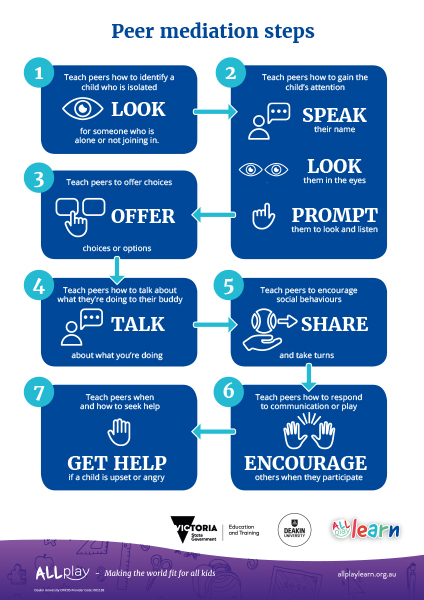
Peer Mediation and Group Work
- What is peer inclusion?
- Characteristics of effective peer inclusion
- Teaching peer mediation
- Group work
Research has found that peer mediation is one of the most effective approaches for supporting the inclusion of students and the development of social skills at school. Peer mediation is particularly relevant for students who find joining in or engaging with peers challenging, such as students with autism.

So what is peer mediation?
Peer mediation involves teaching the peers of students with disabilities how to communicate, include and interact with students who may need support with communication or participation. This involves recognising the impact of the environment and focusing on making changes at this level rather than trying to change the student. The student’s peers may benefit from learning how to adapt their own communication and social approaches to be inclusive of others. Research suggests that peer mediation works best when a student with a disability is also participating in individualised communication or social skills training. Bridging social and communication gaps can be achieved when the student AND their peers actively learn how to communicate and interact with each other.
What if a student or their family do not wish to have their disability disclosed to others?
Peer mediation can be used without identifying a student with a disability. Instead, specific social or communication goals can be identified globally. For example, teachers can mention that a mediator could help students to join in and that being a mediator means students can learn how they can communicate with others who are quiet or don’t use words to communicate.
Could peer mediation negatively impact the wellbeing, inclusion or academic performance of peers?
When done with training and supports in place, research suggests there is no negative impact on the friendships and perceived ‘social status’ of peer mediators. In fact, the only impact that research has identified is that peer mediators are more likely to identify a child with a disability as a friend after being a peer mediator! Peer mediation typically includes a range of peers as mediators, which may also be important for ensuring positive outcomes for all, rather than relying on allocating one particular mediator/buddy to a student with a disability.

Characteristics of effective peer mediation
- Peer mediation typically involves the inclusion of several peers as mediators. Including more than one peer means that a student has many peers to play and interact with and is not dependent on one specific peer (leaving the student without other options if the peer is absent). Interacting with many different peers also helps a student generalize the communication and social skills they are learning.
- Peer mediators who are well-liked and prosocial tend to make great mediators. It may also be important to choose peer mediators who have good social and communication skills.
- Regular training and practice is important for successful peer mediation.

Teaching peer mediation
-
Peers can act as social mediators in the classroom and the playground. Initially, teacher support in the form of prompts may be needed, however this can be faded as students become proficient in interacting with each other. Consider teaching one skill at a time, and giving students time to become proficient in that skill before moving onto the next skill. A range of approaches can help mediators acquire mediation skills. These include:
- Clear instruction
- Role-plays (with teacher or other students)
- Modelling (teacher modelling; video modelling; puppets)
- Practise (students need lots of opportunities to practise and receive feedback)
The following diagram outlines some of the key steps to teach peers to be mediators. For a more in-depth discussion of peer mediation, and videos modelling the process, see the peer mediation lesson in AllPlay Learn’s primary professional learning course.

Group work
Group work can be a positive forum for teaching all students (including students with specific social skill challenges) positive social behaviours such as teamwork, sharing and leadership. It may be important to consider how group work can be tailored for a student’s specific communication abilities, or preference for shorter activities, brief breaks or reduced sensory input. If a student has a special interest area that is shared by other peers, then providing some group activities that involve shared interests can help facilitate friendships.For a more in-depth discussion of group work approaches for students with social and communication challenges, see the Peer mediation lesson on AllPlay Learn’s Primary professional learning course.




Step one
- Provide an overview of relevant characteristics of students with a specific disability and the goals of peer group work
- Use strengths-based language
- Consider and discuss confidentiality
Step two
- Teach peers support strategies for class.
Step three
- Teach peers social or communication skills
Step four
- Talk to peers about when to seek assistance

